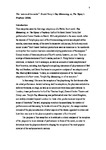The ‘universal favourite’: Daniel Terry’s Guy Mannering; or, The Gipsey’s Prophecy (1816)
| dc.contributor.author | Bautz, Annika | |
| dc.date.accessioned | 2017-09-24T10:15:08Z | |
| dc.date.issued | 2017-09-22 | |
| dc.identifier.issn | 0306-2473 | |
| dc.identifier.issn | 2222-4289 | |
| dc.identifier.uri | http://hdl.handle.net/10026.1/9978 | |
| dc.description.abstract |
Introduction. This essay discusses the first stage adaptation of a Walter Scott novel: Guy Mannering; or, The Gipsey’s Prophecy, by Scott’s friend Daniel Terry, first performed at Covent Garden in March 1816 and published in the same month. After the success of Terry’s play, each of Scott’s succeeding novels was adapted within months, sometimes weeks, of the novel’s respective publication, for both major and minor houses. Scott-based theatrical productions were so numerous in the nineteenth century that their number has been exceeded only by productions of Shakespeare. Critical studies of these adaptations of Scott’s novels, however, are rare. There are surveys of dramatizations of Scott’s works, such as H. Philip Bolton’s masterly overview, or Richard Ford’s catalogue, as well as accounts of some adaptations of Scott’s novels, including Ann Rigney’s compelling discussion of play versions of Rob Roy and Ivanhoe, and David Buchanan’s comparative analysis of two adaptations of The Heart of Mid-Lothian. To date, no extended study exists of the first stage adaptation of a Scott novel, Terry’s Guy Mannering, or of its reception. In this essay, I focus on the reception of the play during the first decade after its initial performance. As well as being itself an adaptation, the play was mediated in different versions, on stage, as well as in luxury and very cheap print editions. In London, it was performed at both of the Theatres Royal, Covent Garden Theatre and Drury Lane. Terry’s Guy Mannering was performed all over the United Kingdom, and widely reviewed beyond London, but these other productions are beyond the scope of this study. As well as gauging reception by quantifying the number of performances and discussing the kinds editions of the play text, the essay considers reviews of the play as indicators of what aspects of the drama appealed to critics and how their reactions to the play compared to responses to Scott’s novel. The purpose of this essay then is to establish a critical analysis of the reception of the play and to relate reviews of performance to those of the novel, in order to determine how the play contributed to shaping the reception of the most popular novelist of the early nineteenth century. | |
| dc.format.extent | 36-57 | |
| dc.language.iso | en | |
| dc.publisher | MHRA | |
| dc.title | The ‘universal favourite’: Daniel Terry’s Guy Mannering; or, The Gipsey’s Prophecy (1816) | |
| dc.type | journal-article | |
| plymouth.issue | 0 | |
| plymouth.volume | 47 | |
| plymouth.publisher-url | http://www.mhra.org.uk/journals/YES | |
| plymouth.publication-status | Published | |
| plymouth.journal | Yearbook of English Studies | |
| plymouth.organisational-group | /Plymouth | |
| plymouth.organisational-group | /Plymouth/Faculty of Arts, Humanities and Business | |
| plymouth.organisational-group | /Plymouth/REF 2021 Researchers by UoA | |
| plymouth.organisational-group | /Plymouth/REF 2021 Researchers by UoA/UoA27 English Language and Literature | |
| plymouth.organisational-group | /Plymouth/Users by role | |
| plymouth.organisational-group | /Plymouth/Users by role/Academics | |
| dcterms.dateAccepted | 2015-10-20 | |
| dc.rights.embargodate | 2018-9-22 | |
| dc.identifier.eissn | 2222-4289 | |
| dc.rights.embargoperiod | 12 months | |
| rioxxterms.licenseref.uri | http://www.rioxx.net/licenses/under-embargo-all-rights-reserved | |
| rioxxterms.licenseref.startdate | 2017-09-22 | |
| rioxxterms.type | Journal Article/Review |


